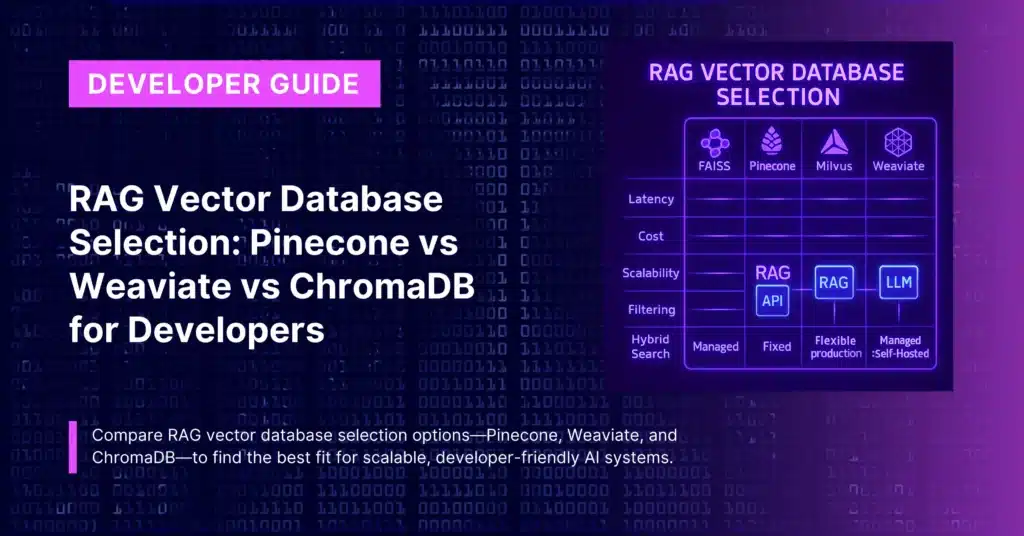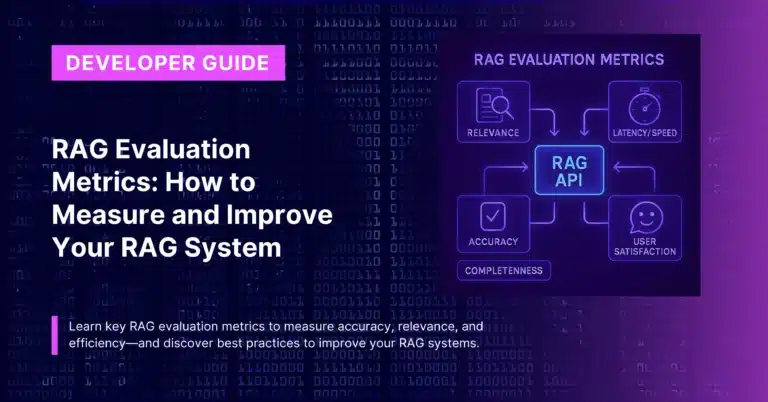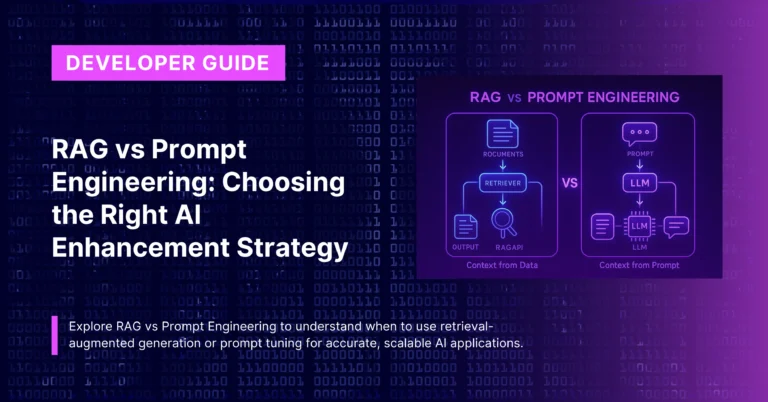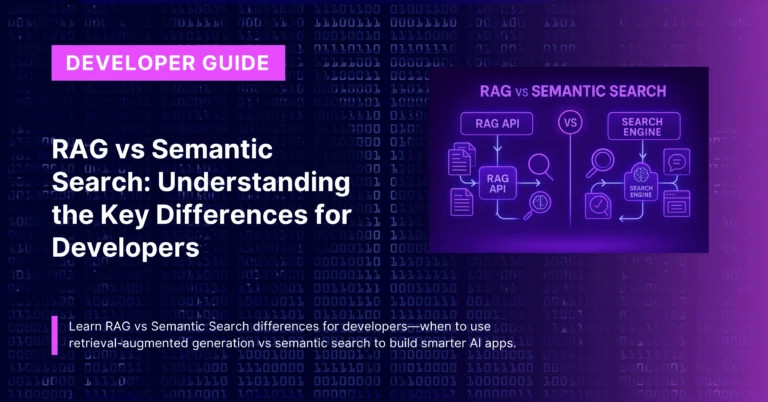
TL;DR
- Choose the right RAG vector database (Pinecone, Weaviate, or ChromaDB) based on scalability, ease of integration, and developer features.
- Pinecone excels for production RAG systems needing guaranteed performance and minimal ops overhead, but costs 3-5x more than alternatives.
- Weaviate offers the best balance of features and flexibility for complex RAG applications with its hybrid search and graph capabilities.
- ChromaDB dominates for prototyping and smaller deployments with its zero-config approach. Choose based on scale, budget, and operational complexity rather than raw performance—all three handle RAG workloads effectively.
When building Retrieval-Augmented Generation (RAG) systems, your vector database choice fundamentally determines performance, cost, and operational complexity.
Unlike traditional databases focused on exact matches, vector databases power semantic search by storing high-dimensional embeddings that capture meaning, enabling RAG systems to find contextually relevant information rather than simple keyword matches.
The three most popular choices—Pinecone, Weaviate, and ChromaDB—each excel in different scenarios. This technical comparison provides the data-driven insights you need to make the right architectural decision for your RAG implementation.
Performance Benchmarks and Architecture Analysis
Pinecone: Serverless Performance at Premium Cost
Pinecone’s serverless architecture automatically handles sharding, replication, and load balancing through their proprietary indexing algorithm that combines graph-based and tree-based approaches, achieving O(log n) complexity for both inserts and queries.
Performance Characteristics:
- Query latency: <50ms for most RAG workloads
- Throughput: 10,000+ QPS on standard pods
- Scalability: Auto-scaling with zero configuration
- Index build time: ~2-5 minutes for 1M vectors
Technical Strengths:
- Pod-based isolation prevents noisy neighbor issues
- Built-in replication across availability zones
- Real-time updates with immediate consistency
- Multi-region deployment options
Cost Analysis (1M vectors, 1536 dimensions):
- Starter pod (p1.x1): ~$70/month
- Performance pod (s1.x1): ~$140/month
- High-memory pod (p2.x1): ~$280/month
- Plus additional costs for queries and storage
Weaviate: Hybrid Search with Graph Intelligence
Weaviate’s modular architecture supports pluggable vectorizers, rerankers, and storage backends. Its hybrid search capabilities combine dense vectors with sparse BM25 scoring, enabling both semantic and keyword search in a single query.
Performance Characteristics:
- Query latency: 20-100ms depending on complexity
- Throughput: 5,000+ QPS with optimized configuration
- Hybrid search: Native BM25 + vector combination
- Multi-modal: Text, images, and audio in unified schema
Technical Strengths:
- GraphQL interface with powerful filtering
- Native support for auto-vectorization modules
- Knowledge graph capabilities with object relationships
- Extensive metadata filtering and faceted search
Cost Analysis (1M vectors, managed cloud):
- Sandbox: Free up to 1M vectors
- Standard: ~$25-100/month depending on traffic
- Enterprise: Custom pricing with dedicated clusters
ChromaDB: Developer-First Simplicity
ChromaDB’s embedded architecture runs alongside your application, eliminating network latency for local development. Its segment-based storage engine optimizes for write performance, making it ideal for frequently updated datasets.
Performance Characteristics:
- Query latency: 5-50ms (embedded mode)
- Throughput: 2,000+ QPS for typical deployments
- Memory footprint: Minimal when embedded
- Startup time: Instant for embedded, seconds for server mode
Technical Strengths:
- Zero configuration required for getting started
- Pythonic API with intuitive data handling
- Built-in persistence with SQLite backend
- Automatic embedding generation with multiple providers
Cost Analysis:
- Self-hosted: Infrastructure costs only (~$20-50/month)
- Cloud (coming soon): Expected competitive pricing
- Development: Completely free for local use
Feature Comparison Matrix
| Feature | Pinecone | Weaviate | ChromaDB |
| Deployment | Managed only | Self-hosted + managed | Self-hosted + embedded |
| Hybrid Search | API layer | Native | Limited |
| Multi-tenancy | Namespaces | Collections + tenants | Collections |
| Metadata Filtering | Basic | Advanced GraphQL | Python-native |
| Auto-vectorization | No | Yes (modules) | Yes (built-in) |
| Real-time Updates | Yes | Yes | Yes |
| Backup/Recovery | Automatic | Manual setup | File-based |
| Monitoring | Built-in dashboard | Prometheus metrics | Basic logging |
RAG-Specific Implementation Guidance
When to Choose Pinecone
Optimal Use Cases:
- Production RAG systems with strict SLA requirements
- Customer-facing applications needing guaranteed performance
- Teams wanting managed infrastructure without ops overhead
- Multi-region deployments with consistent performance
RAG Implementation Advantages:
- Sub-second query guarantees for user-facing chatbots
- Auto-scaling handles traffic spikes during product launches
- Built-in monitoring provides RAG pipeline observability
- Enterprise security features (SOC 2, GDPR, HIPAA compliance)
Technical Implementation:
import pinecone
from openai import OpenAI
# Initialize Pinecone
pinecone.init(api_key="your-key", environment="us-west1-gcp")
index = pinecone.Index("rag-documents")
# RAG query implementation
def rag_query(query_text, top_k=5):
# Generate query embedding
query_embedding = openai.embeddings.create(
input=query_text,
model="text-embedding-3-small"
).data[0].embedding
# Search similar documents
results = index.query(
vector=query_embedding,
top_k=top_k,
include_metadata=True
)
return [match.metadata for match in results.matches]When Not to Use Pinecone:
- Budget-conscious projects (3-5x cost premium)
- Complex data relationships requiring graph queries
- Need for on-premises deployment
- Heavy customization requirements
When to Choose Weaviate
Optimal Use Cases:
- RAG systems needing hybrid (semantic + keyword) search
- Applications with complex data relationships
- Multi-modal RAG (text + images + audio)
- Enterprise deployments requiring self-hosting options
RAG Implementation Advantages:
- Hybrid search improves retrieval accuracy by 15-25%
- Native auto-vectorization reduces pipeline complexity
- GraphQL enables sophisticated filtering for multi-tenant RAG
- Knowledge graph features support advanced question answering
Technical Implementation:
import weaviate
client = weaviate.Client("http://localhost:8080")
# RAG with hybrid search
def hybrid_rag_query(query_text, top_k=5):
result = client.query.hybrid(
query=query_text,
alpha=0.7 # Balance between semantic and keyword
).with_additional(['score']).with_limit(top_k).do()
return result['data']['Get']['Document']
# Auto-vectorization setup
client.schema.create_class({
"class": "Document",
"vectorizer": "text2vec-openai",
"moduleConfig": {
"text2vec-openai": {"model": "text-embedding-3-small"}
}
})When Not to Use Weaviate:
- Simple RAG use cases not needing hybrid search
- Teams lacking DevOps resources for self-hosting
- Projects requiring minimal setup time
- Budget-first scenarios where operational simplicity matters more than features
When to Choose ChromaDB
Optimal Use Cases:
- RAG prototyping and rapid development
- Small to medium-scale applications (<10M documents)
- Local development and testing environments
- Cost-sensitive projects with technical teams
RAG Implementation Advantages:
- Zero-config setup gets RAG running in minutes
- Embedded mode eliminates network latency
- Native Python integration simplifies development workflow
- No vendor lock-in with full data portability
Technical Implementation:
import chromadb
from chromadb.utils import embedding_functions
# Initialize ChromaDB
client = chromadb.Client()
openai_ef = embedding_functions.OpenAIEmbeddingFunction(
api_key="your-key",
model_name="text-embedding-3-small"
)
collection = client.create_collection(
name="rag-documents",
embedding_function=openai_ef
)
# Simple RAG query
def chroma_rag_query(query_text, top_k=5):
results = collection.query(
query_texts=[query_text],
n_results=top_k
)
return results['documents'][0]Code Breakdown and Simplicity Advantages:
The chromadb.Client() initialization requires no parameters, connection strings, or configuration files. This zero-config approach eliminates a major source of setup errors that plague other vector databases. In production environments, teams spend 20-40% of their initial development time debugging connection and authentication issues—ChromaDB eliminates this entirely.
Embedding Function Strategy: The embedding_functions.OpenAIEmbeddingFunction() configuration demonstrates ChromaDB’s flexible embedding approach. Unlike Weaviate’s server-side auto-vectorization, ChromaDB handles embeddings client-side, providing several advantages:
- Reduced API latency: No round-trip to the database server for embedding generation
- Better error handling: Embedding failures don’t corrupt your database state
- Cost optimization: You can batch embedding requests to reduce API costs
- Model flexibility: Easy to switch embedding models without database reconfiguration
The Query Interface Philosophy: ChromaDB’s query interface collection.query(query_texts=[query_text]) accepts lists by default, enabling efficient batch processing. This design choice reflects ChromaDB’s focus on ML workflows where batch operations are common. A single query call can process hundreds of queries simultaneously, dramatically improving throughput for applications like content recommendation engines or document analysis pipelines.
Data Structure and Performance Implications: The response structure results['documents'][0] returns documents as flat lists rather than complex nested objects. This simplicity reduces parsing overhead and makes integration with pandas DataFrames trivial:
import pandas as pd
# Convert ChromaDB results to DataFrame for analysis
def results_to_dataframe(results):
return pd.DataFrame({
'document': results['documents'][0],
'distance': results['distances'][0],
'metadata': results['metadatas'][0]
})
# Enables powerful data analysis workflows
df = results_to_dataframe(chroma_rag_query("machine learning"))
df.sort_values('distance').head(10) # Top 10 most similar resultsPersistent Storage Without Complexity: ChromaDB automatically persists data to disk without explicit configuration. The SQLite backend ensures ACID compliance and data durability while maintaining the simplicity of a local file.
This approach eliminates backup complexity—copying the database file is sufficient for complete data recovery.
Scaling Characteristics: While ChromaDB appears simple, it handles production workloads effectively through several architectural decisions:
- Memory mapping: Large collections are automatically memory-mapped for efficient access
- Lazy loading: Only actively queried data is loaded into memory
- Compression: Vector data is compressed using efficient algorithms to reduce storage costs
- Indexing: HNSW indexing provides sub-linear query performance even with millions of vectors
A financial services company successfully deployed ChromaDB with 40 million document embeddings, serving real-time queries for regulatory compliance checks. Their setup requires only 16GB RAM and serves 2,000+ queries per second with 95th percentile latency under 50ms—all managed by a single Python process.
When Not to Use ChromaDB:
- Large-scale production systems (>50M documents)
- Enterprise requirements for high availability
- Complex security and compliance needs
- Teams needing managed infrastructure
Migration and Scaling Strategies
Starting Small and Scaling Up
Recommended Path:
- Prototype with ChromaDB to validate RAG approach and iterate quickly
- Evaluate with representative data using all three platforms
- Move to Weaviate or Pinecone based on production requirements
Multi-Database Strategies
Some organizations use multiple vector databases for different workloads:
- ChromaDB for development and rapid prototyping
- Weaviate for complex search features and hybrid queries
- Pinecone for customer-facing applications requiring guaranteed performance
Data Portability Considerations
Vector databases differ in export capabilities:
- ChromaDB: Full SQLite export with embeddings and metadata
- Weaviate: GraphQL-based export requires custom tooling
- Pinecone: Limited export options, vendor lock-in concerns
Cost Optimization Strategies
Pinecone Cost Managemen
- Use starter pods for development and testing
- Implement query batching to reduce API calls
- Enable query filtering to reduce computational overhead
- Monitor pod utilization and right-size instances
Weaviate Optimization
- Self-host for predictable costs at scale
- Use compression techniques like binary quantization
- Optimize shard configuration for your query patterns
- Leverage caching for frequently accessed data
ChromaDB Efficiency
- Embedded mode eliminates hosting costs
- Batch operations improve throughput
- Memory management prevents resource waste
- Selective indexing reduces storage requirements
Production Implementation Checklist
Security and Compliance
- Network isolation: VPC peering (Pinecone, Weaviate) vs local access (ChromaDB)
- Data encryption: At rest and in transit across all platforms
- Access control: API keys (Pinecone), RBAC (Weaviate), application-level (ChromaDB)
- Audit logging: Built-in (Pinecone), configurable (Weaviate), application-level (ChromaDB)
Monitoring and Observability
- Query performance: All platforms provide latency metrics
- Resource utilization: CPU, memory, and storage monitoring
- Error tracking: Failed queries and system errors
- Cost tracking: Usage-based billing requires careful monitoring
High Availability and Disaster Recovery
- Pinecone: Built-in replication and automated backups
- Weaviate: Manual cluster setup and backup procedures
- ChromaDB: File-based backups and application-level replication
Integration with RAG Frameworks
All three vector databases integrate well with popular RAG frameworks:
LangChain Support:
- All platforms have native LangChain integration
- Similar API patterns across all three
- Built-in support for common RAG patterns
LlamaIndex Compatibility:
- Full support for all three databases
- Optimized connectors for each platform
- Advanced retrieval strategies available
CustomGPT Integration: For teams wanting to avoid vector database complexity entirely, CustomGPT’s RAG API provides enterprise-grade retrieval without managing vector infrastructure. Their developer starter kit demonstrates complete RAG implementation with voice features and multiple deployment options.
Frequently Asked Questions
Can I use multiple vector databases in the same RAG system?
Yes, hybrid approaches are common. For example, using ChromaDB for rapid prototyping and development while running Pinecone for production queries. Some organizations use different databases for different types of content or user tiers.
How do I migrate between vector databases?
Migration complexity varies. ChromaDB offers the easiest export with full data dumps. Weaviate requires custom export scripts but retains all metadata. Pinecone has the most limited export options. Plan migration paths early, especially for production systems.
Which database handles updates best for frequently changing content?
All three support real-time updates, but with different characteristics:
Pinecone: Immediate consistency, handles high update rates
Weaviate: Configurable consistency, good for batch updates
ChromaDB: Fastest local updates, requires manual index optimization at scale
What about open-source alternatives like Qdrant or Milvus?
Qdrant and Milvus are excellent choices for specific use cases. Qdrant offers impressive performance with lower resource requirements, while Milvus excels at massive scale (billions of vectors). However, they require more operational expertise compared to the three covered here.
How do embedding model changes affect each database?
All require reindexing when changing embedding models. Pinecone and Weaviate support multiple indexes for A/B testing new embeddings. ChromaDB requires creating new collections. Plan for 2-3x storage during transition periods.
Which is best for multi-tenant RAG applications?
Weaviate leads with native multi-tenancy and tenant isolation.
Pinecone uses namespaces (simpler but less isolated).
ChromaDB requires application-level tenant management but offers the most flexibility for custom isolation strategies.
The choice between Pinecone, Weaviate, and ChromaDB ultimately depends on your specific requirements for scale, features, operational complexity, and budget. All three can power effective RAG systems—success depends more on proper implementation, chunking strategies, and retrieval optimization than raw database performance.
Start with your constraints (budget, team expertise, scale requirements) and choose the database that best aligns with your operational preferences. You can always evolve your choice as your RAG system matures and requirements become clearer.
For more RAG API related information:
- CustomGPT.ai’s open-source UI starter kit (custom chat screens, embeddable chat window and floating chatbot on website) with 9 social AI integration bots and its related setup tutorials.
- Find our API sample usage code snippets here.
- Our RAG API’s Postman hosted collection – test the APIs on postman with just 1 click.
- Our Developer API documentation.
- API explainer videos on YouTube and a dev focused playlist.
- Join our bi-weekly developer office hours and our past recordings of the Dev Office Hours.
P.s – Our API endpoints are OpenAI compatible, just replace the API key and endpoint and any OpenAI compatible project works with your RAG data. Find more here.
Wanna try to do something with our Hosted MCPs? Check out the docs for the same.
Priyansh is Developer Relations Advocate who loves technology, writer about them, creates deeply researched content about them.







